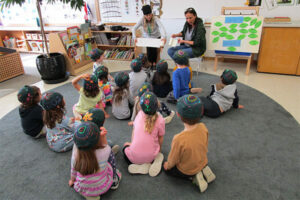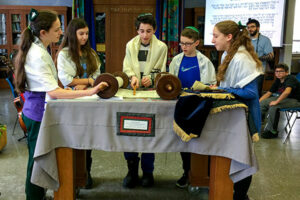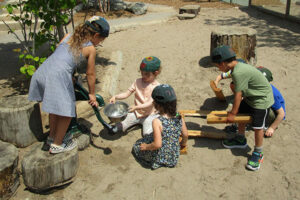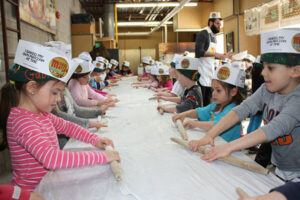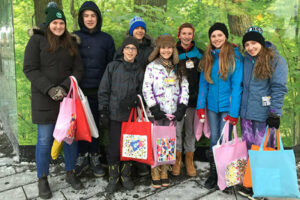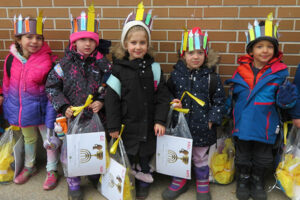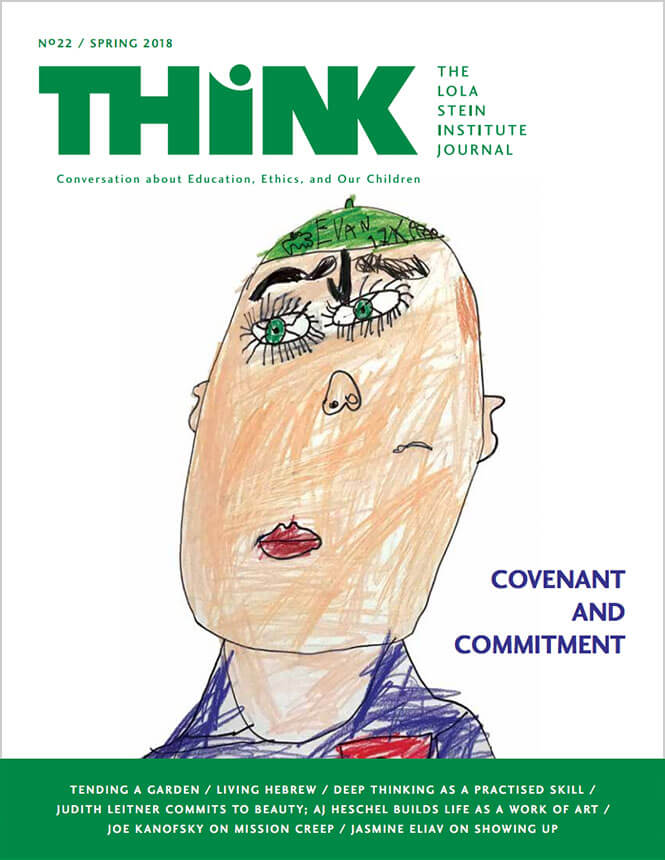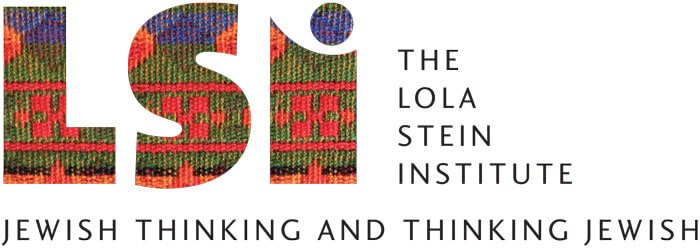- How We Teach

- First Column
- Second Column
- Third Column
- Case Studies

- First Column
- Second Column
- Culture & Community

- First Column
- Second Column
- News & Views

- Admissions

- First Column
- Second Column
- Support Us

- About

- First Column
- Second Column
- Parent Hub
- Attend an Open House
- Take a Tour
- Donate Now
- Calendar
- Blog
- 416-635-1876
- Search
The Bounty of a School Garden
by
“Hey! Wanna see something cool!” That’s all it took for Daniel Abramson, then a new Grade 8 teacher, to get hooked. It was 2010 and Toronto Heschel School Co-Founder Ellen Kessler was in the school garden asking students to take in the wonder around them. The question struck him hard; Daniel saw a new departure for exploration. Now, as the school’s lead environmental educator, he calls out the same question, that patch of ground still supporting limitless reflection.
The school’s environmental ethos stems from an essential Jewish commitment to respect the earth. The garden mirrors the school’s vision. It embodies commitment to integrated learning and is an organic extension of the academic and spiritual inquiry happening inside the school walls. The garden is a metaphor for the education we deliver.
It didn’t sprout overnight. Like the rich learning at Toronto Heschel, the garden was planned thoughtfully, meticulously, and, above all, intentionally. The premise is the awe and wonder that ground the philosophy of Rabbi Abraham Joshua Heschel; he is the school’s namesake and mentor and he asks us to notice what we have, and ponder what we can do with it.
In the spirit of Rabbi Heschel, we are cognizant of the full load of responsibilities we carry: care for the earth, for each other, for Jewish values. The teaching is that, by fulfilling this trust, we come to recognize the fullness of our world. In Rabbi Heschel’s footsteps, our young gardeners learn that they must undertake duties and practise commitment if they are to sustain and share this phenomenon called Earth. To this end, the garden generates awe and wonder, pride and delight in all its stewards, be the students, teachers, administrators, or families.
Commitment blossoms in myriad forms. For some, it’ s a weekly after-school gardening program to tend and weed, harvest the bounty, and put the garden to bed at season’s end. A different kind of dedication appears as educators develop and teach interdisciplinary curriculum that weaves various kinds of learning into how and why our garden grows, from the botanical to the biblical to the business of seeds and layout, from the proverbial to the organic. Another flowering of commitment manifests when graduates return to witness the growth of a certain tree or check on flowers that they planted in class years earlier. However or wherever it shows, The Toronto Heschel School community can be characterized by its evolving dedication to the garden.
Like learning, the garden must take root, grow, and develop; only then can it flourish and bear fruit. Each grade’s curriculum integrates learning from the garden across academic disciplines. In the garden, the children enact the values we teach by experiencing the learning physically, using ne w tools, and getting their hands dirty; they blend universal knowledge with spirituality.
Greg Beiles, Head of School, sees Jewish education fuse with environmental education and works with teachers to design purposeful opportunities that integrate the two. The garden is a case in point. Greg looks for where students might find a moment of awe and for how this unconventional learning setting might spark wonder in their eyes. While curiosity fosters children’s love for natural science, Greg also brings Junior High students outside to encircle a large willow tree as an ideal setting to recite tefillah and connect with God amid God’s creations.
Take, for example, the bees living on the roof of the Junior Kindergarten (JK) classrooms. They have become a school symbol of commitment to ecology. Learning from the Book of Genesis about the days of creation, Grade 1 children study the complex theme that creations combine to form new creations. To make honey, bees (one of God’s animal creations) pollinate the flowers (sown on day three) which then grow, helped by sun and water (days three and four). The honey is harvested and enjoyed by humans, but only after it has had time to rest (day seven). First-hand experience with bees deepens the children’s understanding of the miracles of creation.
Beth Lawrence is a parent volunteer, a professional gardener, and a landscape artist. She professes commitment to growing “the physical and metaphysical garden.” One year, she levelled the earth to start fresh and, doing so, refreshed enthusiasm among faculty, students, and parents. Official Provincial Flowers now grow in the Grade 4 section, enhancing study of the Canadian provinces; a herb garden connects in a special way to Grade 2; and JK students plant potatoes one year, and harvest them the next for delectable latkes on Chanukah.
Beth leads the garden club, which fertilizes meaningful relationships between children and the garden as well as interpersonal relations between families and friends. Shared duties establish collaboration and strengthen bonds within the school community. As parents and grandparents play and work with their children among the vegetables and flowers, Beth notices the older generations taking pleasure in teaching, appreciating the chance to leave their young with lasting knowledge of the world, personally delivered.
Daniel Abramson introduces Grade 7 students to the joy of the unknown; they plant a tree whose fruits they will not see as students but know it will benefit generations to come. Planning for the future means cultivating today for the good of someone else tomorrow.
Daniel teaches about earlier inhabitants of the land that is this garden. His Grade 8 students read the Truth and Reconciliation Act and, in 2015, planted a First Nations Healing Garden of traditional medicinal plants. The class annually harvests tobacco and sweetgrass and welcomes First Nations educators to receive them as gifts. As Grade 8 at Toronto Heschel blends Torah themes with human rights, civil rights, and social action from September to June, the Healing Garden is a hands-on anchor to year-long discussion; students perform concretely useful deeds for the benefit of others, through commitment, not obligation.
Rabbi Heschel wrote, “Our goal should be to live life in radical amazement…get up in the morning and look at the world in a way that takes nothing for granted. Everything is phenomenal; everything is incredible; never treat life casually. To be spiritual is to be amazed.” footnote1
The Toronto Heschel garden is an invitation to take in wonder and be amazed. It sees children explore, play creatively, smell flowers, and measure an asparagus stalk; their horizons expand. How lucky to have this garden. How lucky that our students plant their roots among those of sunflowers, kale, peonies, and fruit trees and, like them, blossom over the course of their years at the school, experiencing awe and wonder time and again.
1 Rabbi A. J. Heschel, God in Search of Man: A Philosophy of Judaism (New York: Farrar, Straus and Giroux. 1976).
Lisa Sheps teaches visual art at The Toronto Heschel School. She studied and practiced architecture before pursuing a career in education, and integrates her art and design background into her daily classroom teaching.
PREVIOUS ARTICLE
Living HebrewNEXT ARTICLE
Live and LearnSpecial Feature
Our Sages Tell Us
Perspectives
 The Lola Stein Institute (LSI) is a centre of inventive educational thinking and addresses the challenge to re-frame schooling for the exigencies of our times.
The Lola Stein Institute (LSI) is a centre of inventive educational thinking and addresses the challenge to re-frame schooling for the exigencies of our times.

